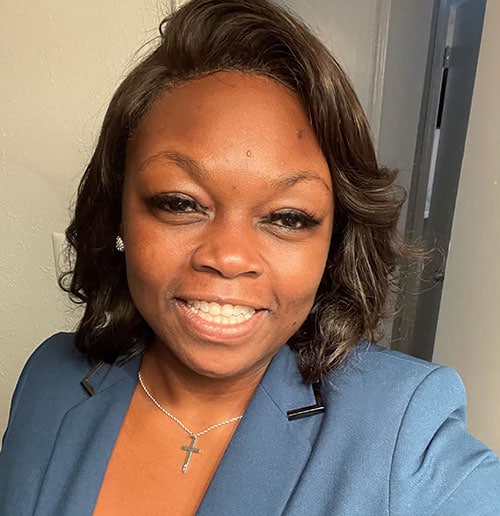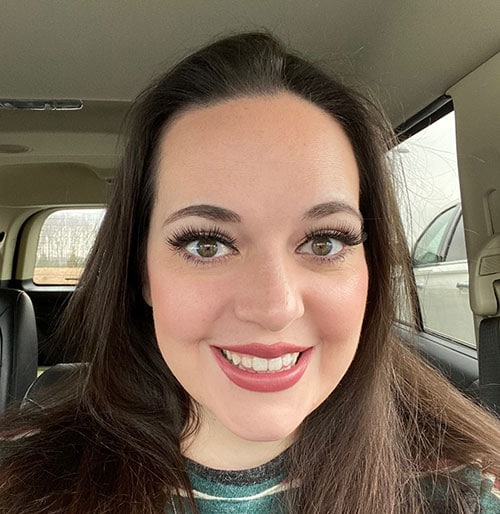My Life With Chronic Disease and Vision Loss
Vision loss ranks among the top 10 causes of disability in the United States. And it can take a major toll on a person’s physical and mental well-being. Read the personal stories of two people who are navigating life with vision loss.
More than 7 million people live with vision loss in the United States, but no two people experience it the same way. Each person with vision loss is unique, and each has their own story to tell. Read on to learn about the personal experiences of two women living with vision loss.
Serena’s Story

Serena knows firsthand how diabetes-related vision loss can impact life and hopes that her story can help others.
In 2003, Serena Valentine was a busy student, doing well in her classes and enjoying college life in general. But her energy wasn’t good—she was tired all the time and assumed the long days of school, studying, and working at night were to blame. The tiredness got worse instead of better, and when she started losing a significant amount of weight without trying, a friend became worried and took her to the emergency room. This is when she was diagnosed with diabetes.
Serena was told that her blood sugar levels were dangerously high and she had a severe kidney infection. Because of her age, doctors diagnosed her with type 1 diabetes. She was prescribed insulin and told she needed to inject it every day to stay alive. She followed her doctor’s instructions but was often sick enough to be hospitalized over the next several years. After further testing, doctors realized she had been misdiagnosed and that she actually had type 2 diabetes.
First Symptoms of Vision Loss
With the correct diagnosis and a new treatment plan, Serena did her best to manage her condition. Serena’s endocrinologist (a doctor who manages diabetes) recommended that she visit other health care professionals for testing to make sure she wasn’t developing any complications. One of the additional tests her doctor recommended was an eye exam. Because she didn’t have any vision symptoms, Serena thought her vision was fine and had put off seeing an eye doctor for years. But by the end of 2017, she began having floaters (small spots that float across your vision) and blurred vision in her right eye. She learned she had developed diabetic retinopathy—one of the leading causes of blindness—and that her retina had become detached.
Serena had to have surgery to have her retina reattached. Although most such surgeries are successful, in severe cases like Serena’s surgery may not work. “Three days after the retina reattachment surgery, I woke up and it was just dark. I had lost total vision in my right eye.”
“Today I’m still completely blind in the right eye, but I have about 30% to 35% vision in the left eye,” she said. “I still try to carry on, continue to work, raise my son as a single mother, and do a lot of work with my nonprofit to raise awareness about vision loss and diabetes.”
Over time, Serena learned to adapt to her new normal—“a life with half my vision.” But while Serena was in a meeting at work, the vision in her left eye suddenly became completely blurred. She could see light but nothing else. She had her mother pick her up from work and immediately drive her to see an eye doctor. The left retina had begun to detach. Fearful of becoming completely blind, she decided against having reattachment surgery. Instead, she went through laser treatments twice a week to try to stop the blood vessels in her eye from bleeding and causing more damage. The progression of her diabetic retinopathy finally slowed and she regained some sight in her left eye.
Managing Diabetes With Low Vision
Vision loss makes it much harder to manage her diabetes. “I have to be careful not to drop my medicine because I won’t be able to see to find it. Reading a glucose monitor can be difficult, so I have to use a more expensive one that has voice and colors to read my levels. I can no longer drive, and have to find other ways to get around. And daily living like cooking and taking care of my son is more challenging.”
Serena’s son has autism and is nonverbal. She relies on visual cues from him to understand what he needs. But he’s learned that his mom has trouble seeing and helps her find her medicine anytime she accidentally drops it. “He’s so happy when he finds it, like he’s won a prize,” she says.
Although Serena has been living with vision loss for years now, she’s still learning how to adapt. “When you feel like you’re losing your independence and you’re an adult, that hurts.”
Learning New Skills to Cope With Low Vision
Serena’s doctor recommended she see a low vision specialist. She admits this was a difficult appointment for her, as it is for many others with vision loss. “It was tough to hear about canes, guide dogs, and special technology,” she says. It felt like admitting she had a disability. But she knows now that vision rehabilitation doesn’t mean giving up who you are. “It’s just a way to gain the skills and tools I need to manage my day-to-day life so that I can keep doing the things I love to do.”
Today Serena focuses on being the healthiest she can be. She admits that physical activity was and still is hard—she has to exercise with caution to avoid retinal bleeding. But she doesn’t let that stop her, because she knows how important physical activity is for diabetes management and her overall health. She recruited her brother, who is an exercise specialist, to help her work out in a safe and effective way. She’s even lost 70 pounds.
Everyday Steps to Preserve Remaining Vision
She also says that managing blood sugar levels is extremely important because it helps protect the vision she has left. She takes it day by day, eating healthy, getting regular physical activity, and supporting others through the ups and downs that come with having diabetes. As a diabetes peer support educator, she teaches others how to manage diabetes by eating healthy and monitoring their blood sugar, and she emphasizes the importance of eye exams. She knows firsthand how diabetes-related vision loss can impact life and hopes that her story can help others.
She also talks to her younger family members about the risk of developing type 2 diabetes. “That type of education starts at home with the family,” she says. “That way kids can learn at a young age so that it becomes normal and not a change they have to make.”
Although Serena lives with vision loss, she says she’s gained more perspective. “I don’t take things for granted, I cherish every moment with my son, and I don’t allow the words ‘I can’t’ in my vocabulary.”
Kristen’s Story

Kristen knows from personal experience that there’s a lot to deal with when your vision is affected.
In 2019, Kristen Craig was diagnosed with rheumatoid arthritis (RA). RA is an autoimmune disease where the immune system attacks healthy cells in the body by mistake, causing inflammation (painful swelling) in the affected parts—in Kristen’s case, her eyes.
Kristen began experiencing painful light sensitivity, redness, and blurred vision in her right eye. At first it was suspected to be pink eye (irritation from an infection or allergies), but after the medicine she was prescribed didn’t help, Kristen knew she had to get in to see an eye doctor. She learned she had uveitis (u-vee-i-tis).
Uveitis happens when the inside of the eye (called the uvea) becomes inflamed, causing redness, extreme and painful sensitivity to light, and blurred vision. Over time, uveitis can cause scar tissue to form inside the eye and permanently damage vision.
Although Kristen had been seeing a doctor for her RA, she had no idea that it could affect her eyes. Her eye doctor explained that not everyone with RA will have uveitis.
Debilitating Flare-ups
When Kristen has a uveitis flare-up, she is in so much pain she can’t leave her bedroom. She needs a 21-day course of steroid eye drops and pills to feel better. That also means 21 days of missing out on family time. Not being able to go to her children’s sports or school functions. Not being able to do normal daily activities like cooking, playing with her children, and spending time with her husband.
Each flare-up means more damage to her eyes, which could mean more vision loss. To try to prevent a uveitis episode, Kristen receives weekly autoimmune injections to keep her body from attacking itself.
Kristen’s uveitis flare-ups have decreased over time, but she knows that they are inevitable because of RA. She hopes that her story will help others who may be living with eye disease not feel so alone. She knows from personal experience that there’s a lot to deal with when your vision is affected.
Healthy Lifestyle Choices, Including Stress Management
“You’re dealing with the mental component, the physical component, and the financial component. I have to see my eye doctor 4 to 6 times a year to monitor the health of my vision. And each one of those visits costs me over a $100, plus the medication for my eyes and my autoimmune injections. It’s not cheap. All of this can cause you to really get depressed about things, to stress and have anxiety.”
Managing stress is important to Kristen because it’s a big factor in her flare-ups. “I like doing yoga or meditation to help manage my stress levels. It’s good for your health too.”
Although autoimmune diseases can’t be prevented, Kristen can prevent other conditions, like type 2 diabetes, that can cause vision loss. This is why she follows these healthy tips:
- Get regular physical activity.
- Follow a healthy eating plan.
- Prevent or manage high blood pressure.
- Take medicines as prescribed.
- Manage stress.